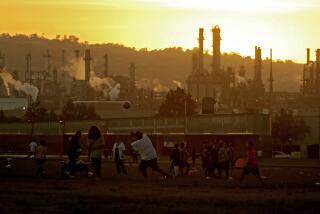Oil Prices Decline to $20-a-Barrel Range : Administration Says It Won’t Interfere; Windfall Profits Tax Begins to Evaporate
Oil prices slid to the $20-a-barrel range before stabilizing Tuesday, and as a result one vestige of the 1979 energy crisis--the windfall profits tax on oil--began to disappear.
So-called Brent crude oil from Britain’s North Sea fell more than $1 to $19.50 a barrel for immediate delivery in London markets, below the $20 barrier that some analysts consider important psychologically. On the New York Mercantile Exchange, the Western Hemisphere’s benchmark crude oil, West Texas Intermediate, fell 67 cents to $20.60 a barrel on the spot market.
But there were signs that prices were scraping bottom after a week of near-panic on world oil markets. Futures contracts for Brent to be delivered in February closed up a nickel to $20.20 a barrel, and February futures in New York for heating oil, gasoline and other refined products traded fractionally higher than the previous day after tracking the declines for crude.
The shrinkage of the tax on “big oil” to the vanishing point was just one of the countless consequences, most of them positive, as the falloff in crude oil prices in world markets caught the attention of the world’s governments.
The Reagan Administration pledged Tuesday not to interfere with the decline, calling it favorable for U.S. consumers and the world economy as well. And leaders of the Organization of Petroleum Exporting Countries, demonstrating renewed power over oil markets by triggering the price decline with a boost in production, were reported prepared to let the price collapse continue.
Again ruling out a tariff on imported oil to prop up prices, White House spokesman Larry Speakes indicated that the Administration might come to the aid of oil-exporting debtor nations for which the price decline is “obviously a problem.”
Mexico and OPEC member Nigeria are considered especially vulnerable because of their huge debts to foreign banks.
Some analysts have predicted that OPEC might let prices fall as low as $7 or $8 a barrel, the point at which the world’s producers would find it uneconomic to continue pumping oil.
Some unnamed OPEC leaders talked that way Tuesday, telling journalists in London that they are “raring for a fight” with non-OPEC producer nations and don’t have any intention of backing out of a price war, despite the severe implications for its member nations’ oil revenues.
After oil prices skyrocketed to nearly $40 a barrel from 1979 to 1981, increased exploration and conservation measures created a worldwide surplus and prices began to slide. Since 1982, OPEC has gradually trimmed production to prevent a sharper fall of prices, which cost the cartel control of the market as non-OPEC members raised production and cut prices.
But, despite the tough talk by some OPEC officials Tuesday, Nigeria’s oil minister denied any wishes for a confrontation with non-OPEC producers and said he doesn’t expect a price war. Kuwait said it will try to enlist the Soviet Union, the world’s largest oil producer, to help stabilize the international market. (Most of the Soviet output goes for domestic use, although it sells a significant amount of oil in Western European.)
Even if prices stabilize at the current $20 range, it will mean a decline of roughly one-third since late November. That will be a boon to consumers because of lower prices for gasoline and other petroleum-based products but a complex problem for oil companies, banks, governments, utility companies and other institutions.
Enacted in 1980
The effect of the price decline on the windfall profits tax--a loss of perhaps $8 billion in tax revenue for the U.S. government this year--is one example.
Enacted by Congress in 1980 after public outrage over enormous oil industry profits that resulted from the big leap in oil prices, the tax on most domestic oil was the largest tax ever levied on a single U.S. industry. It was intended to raise $227 billion in the 1980s.
But declining oil prices have reduced the take each year since 1982, bringing total revenue to about $80 billion for the first six years, according to Treasury Department figures and Energy Department estimates. And it might generate little or nothing this year.
In fact, says Chevron chief economist William Hermann, the U.S. government, not the oil producers, has often taken the brunt of the precipitous decline in oil prices.
An Energy Department economist added that the windfall profits tax has been a “buffer” for the industry that eased the effect of falling oil prices on revenues.
The tax rate is as much as 70% of the difference between the selling price of domestic crude oil and an inflation-adjusted base price set by the legislation. Most base prices in the various categories of oil are now in the $20 range, the economist said--meaning that there’s little or no price gap to tax.
Until that point was reached, Hermann explains, every $1 decline in the price of oil was charged against the producer and the government. For oil taxed at the maximum 70% rate, the government lost 70 cents in revenue and the company 30 cents on every $1 decline in price.
Wall Street took the continued oil price decline as bad news--six oil firms were on the list of most actively traded stocks on the New York Stock Exchange and all closed down Tuesday--but analysts appeared divided about the overall effects of the price falloff on oil companies.
The small firms that make up the bulk of the world’s 20,000 producers will be hardest hit because their entire revenues come from the sale of crude, not from refining and marketing. The larger producers have, in many cases, prepared for a price decline by restructuring, merging and making themselves more efficient since prices began to soften in 1982, says senior economist Thomas McHale of Drexel Burnham Lambert, a New York brokerage house. “Exxon and Shell are not going to be devastated by $20 oil.”
Dividend Cuts
Analyst Frederick P. Leuffer Jr. of C. J. Lawrence predicted, however, that a continuation of prices below $22 a barrel would force some companies with high debt, such as Phillips Petroleum and Unocal, to reduce or eliminate dividends by the third quarter.
And analyst Michael Metz of Oppenheimer & Co. said the problems for oil producers and lenders with major energy loans outstanding could become serious enough for the Reagan Administration to reconsider its longstanding opposition to a tariff on imported oil.
Natural gas utilities, meanwhile, will have to cut their own prices to compete against oil for big industrial customers that can switch readily from one energy source to another, said a spokesman for Southern California Gas, the nation’s biggest gas company.
And lenders such as Security Pacific in Los Angeles note that they provided “a lot of money” to build and upgrade refineries when prices were escalating.
“With the change in trend in prices, they proved uneconomic,” said John F. Kooken, Security Pacific’s chief financial officer. “Brand-new plants were economically obsolescent and therefore major write-offs.”
Times staff writers John Broder, Paul Richter and Karen Tumulty contributed to this story.
More to Read
Inside the business of entertainment
The Wide Shot brings you news, analysis and insights on everything from streaming wars to production — and what it all means for the future.
You may occasionally receive promotional content from the Los Angeles Times.










